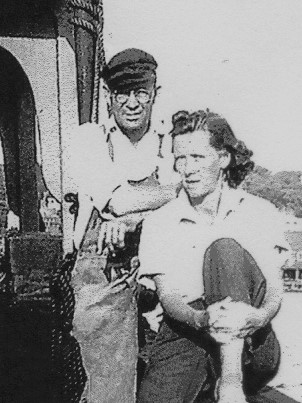HORTON-WILLIAM
WILLIAM LEE HORTON

PVT/CAPTAIN

SPENT HIS LIFE AS A BARGEMAN
The U.S. Merchant Marine has been mostly viewed as large ships sailing across oceans carrying cargos from one country to another and most citizens have little knowledge that the Merchant Marine was established before the U.S. Navy or Coast Guard. A very little-known tradition is that there were people who operated barges dating back to the birth of the nation, a lifestyle our forefathers brought when they landed to establish this country. Families were often on some of the barges, a tradition that is as old as our country. These crews furnished a major source of commerce by river throughout the early United States and companies who owned the barges paid premium wages to those that were manned by families. Barge seamen endured a life that was extremely primitive as most barges were without the average necessities found ashore such as electricity, running water or the usual bathroom conveniences. Heat often came from a simple coal stove also used for cooking and light from kerosene lamps was the norm. Life was primitive and difficult.
Captain William Lee Horton spent his life as a bargeman after Army service as a Private during World War One. Horton was reportedly born on December 6, 1894, and prior to World War II he worked aboard barges on the East Coast, sometimes accompanied by his family. When the U.S. entered World War II, his 17-year old son, who had previously worked aboard barges with his father, decided to follow in his father’s footsteps and became an able body seaman aboard a tugboat that was sunk in March 1942 about eight miles off the entrance to Chesapeake Bay. He did not survive the sinking and this tragedy caused Captain Horton’s wife to decide to leave her aircraft factory job and accompany Horton with their remaining three children aboard his barges. This decision set the course of their lives from then on.
A son of Captain Horton has written that he researched the World War II career of his father and concluded that he successfully made 306 barge trips during the war, accompanied by his family almost 60% of the time. The trips usually originated in Hampton Roads, Virginia, and destinations were usually north to ports in Connecticut, Rhode Island, New Jersey, Massachusetts, Maine, and occasionally as far north as Nova Scotia. Cargos were of war materials such as ore, scrap metals, sugar, salt, lumber, coal, etc. These trips were on unarmed and unescorted vessels through waters where ships were being attacked by German submarines and although Captain Horton reported sometimes seeing a submarine, he was never attacked. The tows moved at a pace of only two to six knots and were sitting ducks for the taking as the threat of being attacked by the enemy submarines was constant. It has been calculated that Captain Horton spent the equivalent of three years during the war on these treacherous waters.
William Lee Horton died on February 17, 1970, and is buried in Highland Park Cemetery in Elizabeth City, North Carolina, next to his son who died in 1942 and his wife who died on December 8, 1997.
Submitted by CDR Roy A. Mosteller, USNR (Ret)

